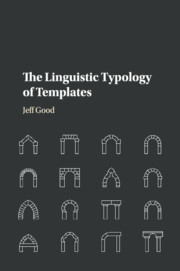Book contents
- Frontmatter
- Contents
- List of figures
- List of tables
- Acknowledgments
- Glossing abbreviations
- 1 Defining template
- 2 A typological description language for templates
- 3 Typologizing templates: case studies
- 4 Typologizing templates: comparison
- 5 Moving forward
- Appendix Specification of template description language
- References
- Author index
- Author index
- Term index
3 - Typologizing templates: case studies
Published online by Cambridge University Press: 05 February 2016
- Frontmatter
- Contents
- List of figures
- List of tables
- Acknowledgments
- Glossing abbreviations
- 1 Defining template
- 2 A typological description language for templates
- 3 Typologizing templates: case studies
- 4 Typologizing templates: comparison
- 5 Moving forward
- Appendix Specification of template description language
- References
- Author index
- Author index
- Term index
Summary
Introduction to the case studies
Chapter 2 developed a typological description language for templatic constructions and introduced, for purposes of exemplification, a number of descriptions of templates and template fragments using that description language. In this chapter, these descriptions – which will often be referred to as formal characterizations below – are presented more systematically via a number of case studies of specific templatic constructions. These case studies should be understood as constituting a convenience sample, rather than a balanced sample, but, at the same time, they are designed to cover a wide enough range of patterns that it is hoped they will offer a reasonable approximation of the variation that would be found via more systematic collection efforts. A convenience sample is adopted at this stage for two reasons. First, the procedure for collecting a “balanced” sample of templatic constructions is not obvious, and it seems sensible, therefore, to at first make sure the typological space is reasonably well explored in qualitative terms before attempting to address an additional concern such as “balance.” Second, in considering a domain that is relatively unexamined typologically, one first needs to, in effect, “test” one's typological models and coding procedures across a diverse array of constructions, which is more efficiently done by using an impressionistic sampling procedure, assembling constructions showing clear surface diversity, than following a more rigid collection procedure. There are, of course, clear drawbacks to adopting such a method, the most important of which being the limited range of typological conclusions one can draw from data sampled in this way but, as Nichols (2007b: 233–234) points out, beginning the investigation of a complex grammatical phenomenon in this way is not unusual in typological studies.
As will be made clear in subsequent sections, several of the templatic constructions to be considered derive from my own work on linearization phenomena. However, most of them are drawn from descriptions developed by other authors. I also include an analysis of two “control” constructions involving linear stipulation so that they can be compared with the templatic constructions. These are the English plural strategy involving suffixal -s and the English verb phrase ordering restrictions on unflagged objects (see Haspelmath (2005: 2) and Malchukov et al. (2010: 8) for use of the term flagging). These are developed in Section 3.13.
- Type
- Chapter
- Information
- The Linguistic Typology of Templates , pp. 104 - 215Publisher: Cambridge University PressPrint publication year: 2016



